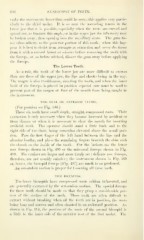Page 608 - My FlipBook
P. 608
(JOO EXTRACTION OF TEETH.
inakt' the inovciuciits faster than could l)c seen ; this applies vei-y pai'tie-
iilarlv to the thirti molar. It is so near the ascendini;- ramus in the
lower jaw that it is possible, especially when the roots are curved and
spread out, to fracture this angle, or in the U])per jaw the tuherosity may
he hrokcn away, thus opening into the maxillary sinus. The gum tis-
sue often adheres to the posterior portion of this tooth ; when this lui])-
\i{^n<. it is best to desist from attempts at (extraction and sever the tissue
from it with a curved lancet or scissors before removing the tooth with
the forceps, or, as before advised, dissect the gum away before applying
the forceps.
The Lower Teeth.
As a rule, the teeth of the lower jaw are more difficult to extract
than are those of the upper jaw, the lips and cheeks being in the way.
The tongue is also troublesome, covering the tooth, and when the inner
beak of the forceps is placed in position especial care must be used to
prevent part of the tongue or floor of the mouth from being caught in
the instrument.
THE ORAL OR ANTERIOR TEETH.
(For position see Fig. 546.)
These six teeth have small single, straight, compressed roots. Their
extraction is only necessary Avhen they become loosened by accident or
from disease or when it is necessary to clear the mouth for inserting
artificial teeth. The operator should stand a little back and to the
right side of the chair, being somewhat elevated above the usual posi-
tion. Pass the first finger of the left hand between the lips and the
alveolar border, and place the remaining fingers beneath the chin with
the thumb on the inside of the teeth. For the incisors use the lower
root forceps shown in Fig. 499 or the universal forceps shown in Fig.
489. The canines are larger and more firmly set ; delicate root forceps,
therefore, are not usually suitable ; the instrument shown in Fig. 489
or, better, the bicuspid forceps (Fig. 497) are much to be preferred.
An out-and-in motion is proper for loosening all these teeth.
THE BICUSPIDS.
The lower bicuspids have compressed roots seldom bifurcated, and
are generally extracted by the out-and-in motion. The special forceps
for these teeth should be made so that they grasp a considerable por-
tion of the surface of the tooth. These teeth are often diflficult to
extract without breaking when all the teeth are in position, the roots
being long and narrow and often situated in an awkward position. As
shown in Fig. 518, the position of the roots of the second bicuspid is
a little to the inner side of the anterior root of the first molar. The


